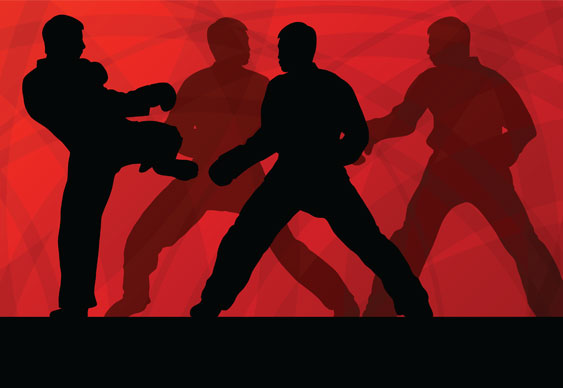Poker Evolution Part 5
Wednesday, 24 September 2014
Five Keys to stay ahead of the game
By Nicolas Levi.
Poker is adaptation. The top players are the ones who find the best style against their opponents. As poker has evolved, so have the weapons of the poker players. In this series, we will analyse how poker strategy got to where it is today, and where it will go tomorrow. Follow me on this journey and you'll know how to adapt to new conditions, table textures, and what to do in delicate unknown spots. Here we learn to ask ourselves, “Why?” rather than just “How?”
Staying ahead in today’s game
So here we are, in 2014. Together, through the past articles of this series, we have analysed four revolutions in the history of the game. We watched Doyle Brunson terrorize the high limit games with his groundbreaking use of aggression and pressure. The fold equity revolution. We studied how Stu Ungar ran circles around his weak tight-opponents during his third WSOP title, being seemingly very aggressive, but cautious nonetheless. The post-flop revolution. Then it was the internet kids running the show, inventing a new standard of “small ball poker” and having difficulties taming the aggression of the likes of Gus Hansen. Poker strategy eventually reached a maturity that we discussed in our last article, where the poker greats began to navigate against improved smallball players as fearless efficient pre-flop grinders. Congratulations for making it to the last article of this series. If you missed an episode, you can find the links at rankinghero.com/nicolas.levi.
So what now? Every evolution was a response to the current game texture. The knowledge in the previous articles will help you predict the trends, rather than react to them. To help you make sense of all this I will give you five keys to stay ahead of the game, and my opinion on where the game may go next - at least for tournament poker, which I know well. But that’s not all: knowing how to play in theory is great, but as strategy gets more complex, it becomes increasingly important to bring your best game to the table at all times. Keys 4 and 5 focus on the mental side of things. No weak clichés there: after making a good living from the poker table for a decade, I am giving you the keys used by those that walk the walk when it comes to their mindset.
Key No. 1: Practice every style
Today, game styles are starting to blur. Smallball players learn from the pre-flop players. Pre-flop players learn from post-flop artists. Post-flop artists are kept in check by longball aggro players. Yet each style has roots that go deep, and there is an inherent rock-paper-scissors game against all but the most complete poker players. You must practice all the styles, so when people throw rock, you will know your paper well.
Understand this: not only do you need to know all styles to adapt to your table, but practicing each style is the only way to learn what works against it. As an added benefit, when you get out of your comfort zone and take different kinds of risks, your brain is fully awake and focused on learning.

Take note of how your opponents react, of the dynamic you create. Learn to play the style well at lower limits, and pay attention to the mistakes that lesser players make against you. Do they three-bet more when you are expecting it, and are you ready to punish them with a four-bet? Do they give up pots at the moment you decided you were on your last barrel before letting them win it? Is this strong player always avoiding your traps and giving you tough decisions? Each style profits from some reactions (more specifically, when you adapt wrongly) but loses, or at least struggles, against the right adjustments. Once you know what you like to see and what puts you to the test when playing a certain style, either play it when it’s right, or face it when you have to.
Key No. 2: Focus on table dynamics and imagePracticing all the styles you can will make you a complete player, capable of adapting to most tables. It’s a good start, but not enough at real tough tables. More and more complete players exist and they too will adapt to avoid being exploited. If everyone plays well, table image and dynamics become the most important thing to watch for.
Be aware of your image at all times, and note that it may be different from the way you really play. Perhaps you found a good pair on the button and re-raised a loose opponent. At that point, everybody suspects you are taking advantage of position. If someone comes over the top and the raiser goes all in, you will have to fold a strong hand. Your opponents will remember that you three-bet the button then folded.
Interestingly, your image may be different from one player to the next, depending on their thinking process. The tough pro might recognise that your four-bets were against one player who was bullying you, and observe that you play solidly otherwise. Meanwhile, a less astute or focused opponent will conclude that you’re loose aggressive all around. In this case, the pro is a possible target for a double-barrel bluff, while the amateur should be taken to value town when you have it.
Table dynamics is a concept thrown around a lot and difficult to grasp, so I’ll give you a classic example. Suppose you play at a big Sunday tournament, and find yourself at a table of internet pros and amateurs. You start by playing aggressively and exploiting the weak players.
Meanwhile most of the pros are multi-tabling, and remain tight until the blinds start to get bigger. Some amateurs bust and are replaced with more good players. As the average stack gets below 35 big blinds your image is very aggressive, and the pros start to play pre-flop poker. The table dynamic has changed completely: more three- and four-bets, less flops. You realise that your smallball style is not fit for the table anymore. What now?

You could very well decide to play pre-flop poker too, and nullify everyone’s edge by playing the same style. In general, that is the safest thing to do to avoid getting run over: accept the increased risk and deny your opponents the right to bully you. In this case, I like to let my image speak for me. I don’t need to risk huge flips right now; oddly, the more I fold, the more my opponents expect a move from me. After all, they know me: I am aggressive, and I must be fuming inside, right?! This paradox enables me to wait out the storm and get my money in as a big favourite when I pick up a decent hand. So here the table dynamic allows me an another, better option: I don’t need to defend with my chips now, my reputation is enough. Worst comes to worst, I will run card dead and my image will become tight aggressive, at which point I can make some moves to grind and get some small pots uncontested. Look out for changes in the dynamic, your table image, or for your opponents to reveal their leaks.
Key No. 3: Follow the leaksA leak is a hole in someone’s game, a specific weakness that all of us have and that slowly costs us money. For example, one player might respect two barrels too much, or open every button despite having two pre-flop grinders with 20 big blinds behind him. Look for leaks in your game by reviewing your sessions with friends, and share spots that you find difficult with an online community like RankingHero.com. You can find me on there, and I’ll be happy to help.
Following opponents’ leaks is speciality of the post-flop artist. He collects them, sometimes along with live tells. Think of other players' leaks as a mini game texture that you can exploit. You might not normally three-bet a lot out of position against a pre-flop grinder, but maybe this particular opponent respects this play too much – as a result it becomes a no brainer, and you can keep the bets small to minimize risk.

Some leaks are shared by many. I believe tournament players are so careful about position nowadays, they have become weak in blind defense. Perhaps weak is incorrect, as they three-bet a lot and are tough to steal from. They do, however, miss value in spots where they should call. Since everyone tends to three-bet the big blind or fold, no-one gets to practice playing in a single raised pot against the blinds. If you’re confident post-flop, have a decent stack, and know how to play out of position, you can take advantage of this. Practice donk bets, check raises, and check calls. You will be surprised at how badly your opponents adapt.
Key No. 4: Bring your A-GameThe three keys above are easy to put on paper, but require you to be focused, seeing the table as a unique problem with a unique solution. Key No. 1 states that your first goal at the table is to recognise the natural style of your opponents. This can be tricky as they may have bits of two or three styles. Key No. 2 means that you are aware of your image, relative to the level of thinking of your opponents, and keep track of the game flow. Key No. 3 means observing hands and reviewing everyone’s decisions in order to notice the holes in their games. To use these keys, you will need to be emotionless and completely focused on your task, analyzing the data coldly. That’s on the inside, mind you. Feel free to use friendly trash talk and have a good time on the outside. This will especially keep you in an upbeat mood if you’re a people person.

So how do you bring your A-Game to the table? This is not easy, but just the fact that you’re reading this article means you’re keen on doing your best. My advice is to set an explicit goal. Something achievable but ambitious, and something that can be measured. It may be moving up in limits (while respecting your bankroll) within a few months. Your goal should be within your control, if you progress well. Once your goal is set, write it down to commit to it. You may or may not achieve it, and that is not the most important part! This goal is meant to help you set the direction, and find the focus that comes with it. Your actions have to line up with your goal otherwise, you’re stuck in a state of frustration, not doing anything to evolve. You might commit to practice every style at lower limits, and make notes of each inherent strength/weakness you discover. You might decide to sign up to a poker community and start sharing strategy (hey, I know a community that’s super awesome… something ranking… something hero… what was it again?)
When you start moving towards your goal, something amazing starts to happen: whenever you sit at a poker table, you feel more prepared and ready to play your A-Game. When I have done the right things, be it studying, going to the gym before an event, getting the right amount of sleep beforehand, analysing my opponents stats at the table, etc – I mentally look at each one in the eye and think, “I am better prepared than you are. I have an edge.” From there, I am proud of my poker, and my A-Game flows naturally. Finally accept that things can move slowly and cut yourself some slack. As long as you’re going towards your goal, you’re on the right path.
Key No. 5: Raise your B-GameIf there's something that all champions know, it's that it is impossible to stay in the zone forever. If you’re in cash games, you might be okay to leave. Phil Ivey does exactly this when he starts losing a couple of big pots against a strong heads up opponent. No ego there. In a tournament, you have to keep playing through various mental states while fighting off tiredness. No matter how much you improve your A-Game, what will make the biggest difference is the quality of your B-Game, and whether you allow yourself to drop to your C, D, E, or even Z-game. Many people can play great poker for a few rounds or hours. The real difference between a great and a good player is what they do when they’re not at their best.
Personally, I learned to acknowledge fatigue, doubt, frustration, or whatever feeling of injustice that pops up to take me off “the zone”. Nowadays, I instantly stop playing 'cute' and revert to a strong solid style that I can play in my sleep and is tough to exploit. Sometimes confidence doesn’t come back, and I spend the entire day playing my B-Game. That’s okay – the spots I miss are not worth trying too hard for if it means I risk dropping to C-Game, or at worst, complete tilt! When this happens to you, my advice is to relax for a few minutes, listen to some music, look away from the table during a couple of hands, and take a step back mentally.
Throwing my ego away might have been the toughest, most counter-intuitive, yet most profitable thing I ever did in poker. For all of you out there, I wish you the same success. I hope you enjoyed this series. Thank you for reading this far, but most importantly – good luck at the tables.